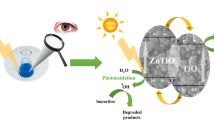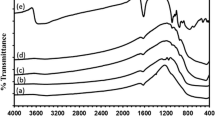Abstract
Hybrid photocatalysts based on TiO2-anatase matrix, representing the both micro- and nano-structures, impregnated with selected lanthanide diphthalocyanine and metalloporphyrin sensitizers, were compared to evaluate their activity and effectiveness in a water suspension catalytic system designed to degrade 4-nitrophenol (4-NP) in a UV-stimulated reaction. Either type of the anatase catalyst was proved to be effective in mineralizing of 4-NP. However, kinetic studies confirmed that the composite’s efficiency basically depends on the nature of the macromolecular sensitizer and to a minor extent on the dimensions (micro/nano) of the TiO2 particles. The apparent higher activity observed for the micro-TiO2 catalysts indicates improvement of the electron transfer between the sensitizer and the micro-crystalline structure of TiO2-anatase in contrast to the nano-crystalline matrix. The mechanistic aspects of the observed catalytic performances have been discussed.
Similar content being viewed by others
Notes and references
G. Marcì, E. García-López, G. Mele, L. Palmisano, G. Dyrda and R. Słota, Comparison of the photocatalytic degradation of 2-propanol in gas-solid and liquid-solid systems by using TiO2–LnPc2 hybrid powders, Catal. Today, 2009, 143, 203–210.
G. Mele, R. Del Sole, G. Vasapollo, E. García-López, L. Palmisano, J. Li, R. Słota and G. Dyrda, TiO2 -based photocatalysts impregnated with metallo-porphyrins employed for degradation of 4-nitrophenol in aqueous solutions:Role of metal andmacrocycle, Res. Chem. Intermed., 2007, 33, 433–448.
G. Mele, E. García-López, L. Palmisano, G. Dyrda and R. Słota, Photocatalytic degradation of 4-nitrophenol in aqueous suspension by using polycrystalline TiO2 impregnated with lanthanide double-decker phthalocyanine complexes, J. Phys. Chem. C, 2007, 111, 6581–6588.
C. Wang, G. Yang, J. Li, G. Mele, R. Słota, M. A. Broda, M. Duan, G. Vasapollo, X. Zhang and F. X. Zhang, Novel meso-substituted porphyrins: synthesis, characterization and photocatalytic activity of their TiO2 — based composites, Dyes Pigm., 2009, 80, 321–328.
R. Słota, G. Dyrda, Z. Hnatejko, J. Karolczak and Z. Stryła, Effect of air absorbed oxygen andmoisture on the chemical stability of photoexcited phthalocyanines in dimethylformamide, J. Porphyrins Phthalocyanines, 2006, 10, 43–54.
M. Anpo, T. Shima, S. Kodama and Y. Kubokawa, Photocatalytic Hydrogenation of CH3CCH with H2O on Small-Particle TiO2,: Size Quantization Effects andReaction Intermediates, J. Phys.Chem., 1987, 91, 4305–4310.
X. Chen and S. S. Mao, Titanium Dioxide Nanomaterials: Synthesis, Properties, Modifications and A pplications, Chem. Rev., 2007, 107, 2891–2959.
N. Balázs, D. F. Srankó, A. Dombi, P. Sipos and K. Mogyorósi, The effect of particle shape on the activity of nanocrystalline TiO2 photocatalysts in phenol decomposition. Part 2: The key synthesis parameters influencing the particle shape and activity, Appl. Catal., B, 2010, 96, 569–576.
M. Andersson, H. Birkedal, N. R. Franklin, T. Ostomel, S. Boettcher, A. E. C. Palmqvist and G. D. Stucky, Ag/AgCl-Loaded Ordered Mesoporous Anatase for Photocatalysis, Chem.Mater., 2005, 17, 1409–1415
M. E. Davis, Ordered porous materials for emerging applications, Nature, 2002, 417, 813–821
H. Shibata, T. Ogura, T. Mukai, T. Ohkubo, H. Sakai and M. Abe, Direct Synthesis of Mesoporous Titania Particles Having a Crystalline Wall, J. Am. Chem. Soc., 2005, 127, 16396–16397.
J. Tang, Y. Wu, E. W. McFarland and G. D. Stucky, Synthesis and photocatalytic properties of highly crystalline and ordered mesoporous TiO2 thin films, Chem. Commun., 2004, 1670–1671.
Z. Zhang, C. C. Wang, R. Zakaria and J. Y. Ying, Role of particle size in nanocrystalline TiO2-based photocatalysts, J. Phys. Chem. B, 1998, 102, 10871–10878.
T. Peng, D. Zhao, K. Dai, W. Shi and K. Hirao, Synthesis of titanium dioxide nanoparticles with mesoporous anatase wall and high photocatalytic activity, J. Phys. Chem. B, 2005, 109, 4947–4952.
J. Wang, W. Sun, Z. Zhang, X. Zhang, R. Li, T. Ma, P. Zhang and Y. Li, Sonocatalytic degradation of methyl parathion in the presence of micron-sized and nano-sized rutile titanium dioxide catalysts and comparison of their sonocatalytic abilities, J. Mol. Catal. A: Chem., 2007, 272, 84–90.
J. Saien and A. R. Soleymani, Comparative investigations on nano and micro titania photocatalysts in degradation and mineralization: use of turbidity in kinetic studies, J. Iran. Chem. Soc., 2009, 6, 602–611.
M. H. Priya and G. Madras, Photocatalytic degradation of nitrobenzenes with combustion synthesized nano-TiO2, J. Photochem. Photobiol., A, 2006, 178, 1–7.
S. Y. Chae, M. K. Park, S. K. Lee, T. Y. Kim, S. K. Kim and W. I. L ee, Preparation of size-controlled TiO2 nanoparticles and derivation of optically transparent photocatalytic films, Chem. Mater., 2003, 15, 3326–3331.
R. Beranek and H. Kisch, Tuning the optical and photochemical properties of surface-modified TiO2, Photochem. Photobiol. Sci., 2008, 7, 40–48.
Q. Sun and Y. Xu, Sensitization of TiO2 with aluminium phthalocyanine: factors influencing the efficiency for chlorophenol degradation in water under visible light, J. Phys. Chem. C, 2009, 113, 12387–12394.
D. Robert and J. V. Weber, Titanium dioxide synthesis by sol gel methods and evaluation of their photocatalytic activity, J. Mater. Sci. Lett., 1999, 18, 97–98.
C. Su, B.-Y. Hong and C.-M. Tseng, Sol–gel preparation and photocatalysis of titanium dioxide, Catal. Today, 2004, 96, 119–126.
S. Qiu and S. J. Kalita, Synthesis, processing and characterization of nanocrystalline titanium dioxide, Mater. Sci. Eng., A, 2006, 435–436, 327–332.
H. W. Van der Marel and H. Beutelspacher, Atlas of Infrared Spectroscopy of Clay Minerals and their Admixtures, Elsevier, Amsterdam, Oxford, pp. 257–259.
M. S. Dieckmann and K. A. Gray, A comparison of the degradation of 4-nitrophenol via direct and sensitized photocatalysis in TiO2 slurries, Water Res., 1996, 30, 1169–1183.
J. Lea and A. A. Adesina, Oxidative degradation of 4-nitrophenol in UV-illuminated titania suspension, J. Chem. Technol. Biotechnol., 2001, 76, 803–810.
Author information
Authors and Affiliations
Corresponding author
Additional information
This paper is published as part of the themed issue of contributions from the 6th European Meeting on Solar Chemistry and Photocatalysis: Environmental Applications held in Prague, Czech Republic, June 2010.
Rights and permissions
About this article
Cite this article
Słota, R., Dyrda, G., Szczegot, K. et al. Photocatalytic activity of nano and microcrystalline TiO2 hybrid systems involving phthalocyanine or porphyrin sensitizers. Photochem Photobiol Sci 10, 361–366 (2011). https://doi.org/10.1039/c0pp00160k
Received:
Accepted:
Published:
Issue Date:
DOI: https://doi.org/10.1039/c0pp00160k




